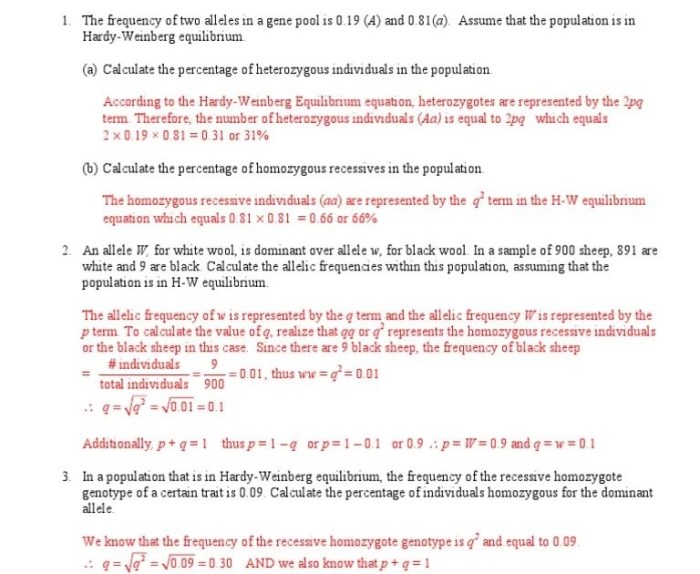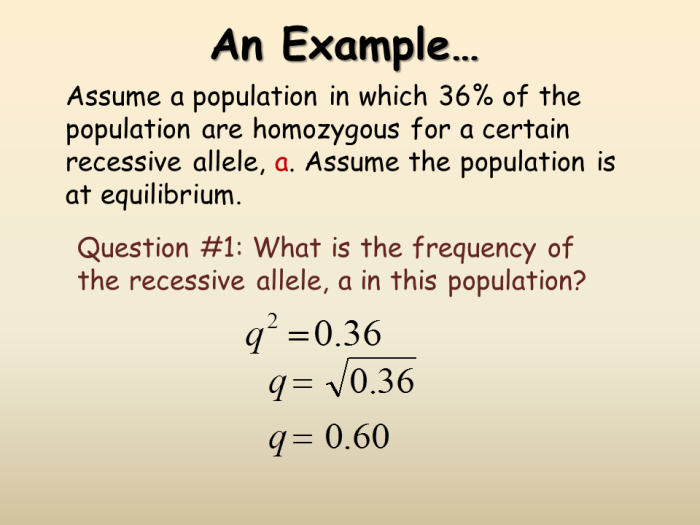Hardy weinberg practice problems with answer key – Delving into the realm of population genetics, we present ‘Hardy-Weinberg Practice Problems with Answer Key,’ an invaluable resource designed to illuminate the intricacies of genetic equilibrium. This comprehensive guide empowers students and researchers alike to grasp the fundamental principles and applications of Hardy-Weinberg equilibrium.
Within these pages, you will embark on a journey through the calculation of allele and genotype frequencies, gaining proficiency in solving practice problems that reinforce your understanding. The accompanying answer key provides invaluable insights into the reasoning behind each solution, solidifying your grasp of the concepts.
1. Introduction to Hardy-Weinberg Equilibrium
Hardy-Weinberg equilibrium is a principle that describes the genetic variation in a population that is not evolving. It states that the frequencies of alleles and genotypes in a population will remain constant from generation to generation in the absence of disturbing factors.
The conditions for Hardy-Weinberg equilibrium are:
- No mutation
- No gene flow
- No genetic drift
- No natural selection
- Random mating
Hardy-Weinberg equilibrium is important in population genetics because it provides a baseline against which to compare populations that are evolving. If a population is not in Hardy-Weinberg equilibrium, then it is likely that one or more of the conditions for equilibrium are not being met.
2. Allele and Genotype Frequencies
Allele frequencies are the frequencies of different alleles in a population. Genotype frequencies are the frequencies of different genotypes in a population.
To calculate allele frequencies, you simply divide the number of copies of an allele by the total number of alleles in the population. For example, if there are 100 copies of allele A and 50 copies of allele a in a population, then the allele frequency of A is 100/150 = 0.67 and the allele frequency of a is 50/150 = 0.33.
To calculate genotype frequencies, you use the Hardy-Weinberg equation:
“`p^2 + 2pq + q^2 = 1“`
where p is the frequency of the dominant allele, q is the frequency of the recessive allele, and p^2, 2pq, and q^2 are the frequencies of the homozygous dominant, heterozygous, and homozygous recessive genotypes, respectively.
For example, if the allele frequency of A is 0.67 and the allele frequency of a is 0.33, then the genotype frequencies are:
- AA: p^2 = (0.67)^2 = 0.4489
- Aa: 2pq = 2(0.67)(0.33) = 0.4482
- aa: q^2 = (0.33)^2 = 0.1029
3. Practice Problems

1. A population of 100 individuals has 60 alleles for the A blood type and 40 alleles for the B blood type. What are the allele frequencies of A and B?
2. A population of 50 individuals has the following genotype frequencies: AA: 0.25, Aa: 0.50, aa: 0.25. What are the allele frequencies of A and a?
3. A population of 100 individuals is in Hardy-Weinberg equilibrium for a single gene with two alleles, A and a. The allele frequency of A is 0.7. What are the genotype frequencies?
Answer Key
1. p(A) = 0.6, p(B) = 0.4
2. p(A) = 0.75, p(a) = 0.25
3. p^2 = 0.49, 2pq = 0.42, q^2 = 0.09
4. Deviations from Hardy-Weinberg Equilibrium

Hardy-Weinberg equilibrium is a theoretical concept, and in reality, populations often deviate from equilibrium. Factors that can cause deviations from equilibrium include:
- Mutation
- Gene flow
- Genetic drift
- Natural selection
- Non-random mating
Deviations from Hardy-Weinberg equilibrium can have a number of consequences, including:
- Changes in allele frequencies
- Changes in genotype frequencies
- Evolution
5. Applications of Hardy-Weinberg Equilibrium: Hardy Weinberg Practice Problems With Answer Key

Hardy-Weinberg equilibrium has a number of applications in population genetics, including:
- Estimating allele and genotype frequencies
- Testing for deviations from equilibrium
- Studying the effects of evolution
- Predicting the genetic consequences of conservation and management practices
Hardy-Weinberg equilibrium is a powerful tool for understanding the genetic variation in populations. However, it is important to remember that it is a theoretical concept, and in reality, populations often deviate from equilibrium.
Key Questions Answered
What is the significance of Hardy-Weinberg equilibrium in population genetics?
Hardy-Weinberg equilibrium serves as a fundamental concept in population genetics, providing a baseline against which to compare observed genetic variation. It allows researchers to assess the stability of gene frequencies over time and identify factors that may be driving evolutionary change.
How can I calculate allele and genotype frequencies?
Allele frequencies are calculated by dividing the number of occurrences of a particular allele by the total number of alleles in the population. Genotype frequencies are calculated by squaring the allele frequencies and summing the products for each possible genotype.
What factors can cause deviations from Hardy-Weinberg equilibrium?
Deviations from Hardy-Weinberg equilibrium can arise due to various factors, including non-random mating, gene flow, genetic drift, mutation, and natural selection. These factors can alter gene frequencies and disrupt the equilibrium state.